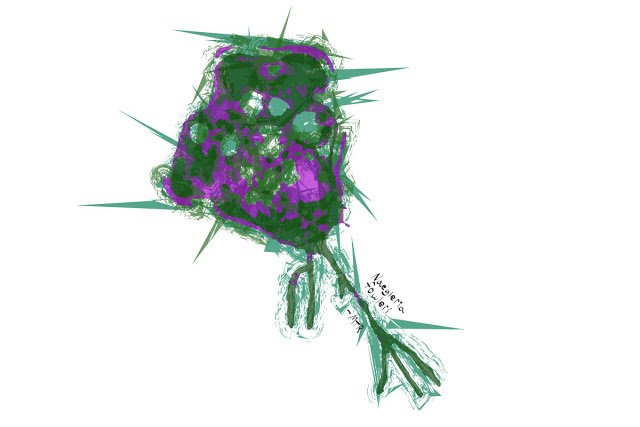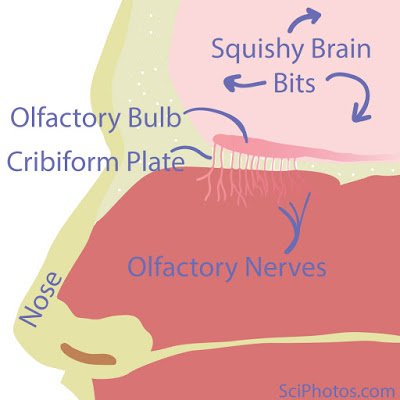The Brain Killing Amoeba

Naegleria fowleri
When the body is infected by some foreign agent such as a virus or a bacterium the body’s immune system fights back and hopefully eliminates the intruder before it can do too much damage. The process of hunting down the infection and eliminating it takes time, time in which an intruder is killing off cells. Despite the fact that the infection causes damage, the body is fairly resilient and can replace the missing cells with relatively little fuss.
Replacing cells in the brain is a whole different matter though. Despite recent research showing that some adult neurons can be replaced, it is not as “simple” a process as with other parts of the body. One reason is that a relatively small number of neurons can control vital functions such as heart rate and breathing. This means that even if you could replace those cells if lost, it is unlikely the body would be able to do it fast enough to save the organism. Also, even if you replaced the neuron, you still need to replicate its connections with other neurons. It is the connections between cells that store information such as memories.
Given that the brain is so special, what are we to do when the world is chock full of tiny little monsters trying to get at our soft, juicy, cellular mechanisms?

Well, like any good paranoid individual, you build a fence. This is where we get the 'blood-brain-barrier. Unsurprisingly, the blood-brain-barrier is a barrier between the blood stream and the brain. This means that any infectious agents you happen to pick up after you “accidently” ate David’s two week old, half eaten, sandwich leftovers won’t make it to the brain. Better luck next time David! This also means that, unlike the rest of the body, where nutrients freely flow out of the blood stream, they have to be actively transported into the brain (nutrients like those derived from David’s petrified sandwich). The fact that most things have to be actively transported across the barrier is a huge problem for developing pharmaceuticals that can get into the brain (but that’s a topic for another post).
Instead, we’re going to talk about one of the few places where the blood-brain-barrier is nonexistent and the horrible, horrible consequences. First, we need to talk about the olfactory (smell) system. The ability to smell is one of the most primitive sensory systems (meaning it evolved earlier than other sensory systems). This makes sense when you think about what your sense of smell is: It’s a chemosensory system, which just means it detects chemicals in the environment. This is a great system for determining whether or not to eat something. If you would have smelled David’s old sandwich, perhaps you wouldn’t have eaten it. But who has time for smelling?
Your sense of smell is the one sensory system in which the sensory receptors have direct access to its primary sensory area of the brain. All of the other systems including touch and sight go through what’s called the thalamus before being directed to their respective primary sensory cortices. This means that in order for the olfactory sensors at the top of your nasal cavity to get to the brain they have to go through the skull and into the olfactory bulbs of the brain. The tiny holes through which the olfactory nerves pass are part of what’s called the cribriform plate.

(Based on: https://en.wikipedia.org/wiki/Olfactory_bulb Wikimedia commons)
A quick aside on anosmia.
Anosmia refers to the condition in which an individual has no sense of smell. Anosmia can be caused by many things, including a good hit to the head. So look at the picture above and imagine you just bailed off your bike. Unfortunately, you were not wearing a helmet so you hit your head on the pavement. Your squishy brain bits will contort while you non-squishy skull bits won’t. This means that if hit sufficiently hard your skull will shear through your olfactory nerves, cutting them off from the olfactory bulb. This results in an inability to detect smells. Fortunately though, your olfactory nerves generally replace themselves with relative ease so your sense of smell should recover. The other damage from the traumatic brain injury however is much harder to repair.
OK, so given the structure of the cribriform plate you might see where this could cause some problems (aside for the potential to slice all your olfactory nerves from a head impact). Not only do you not have the blood brain barrier protecting you here, this is also the only part of the body where the brain is potentially exposed to the outside environment.

Close-up of the cribriform plate.
Notice the small holes through the skull in which the nerves travel through to get to the olfactory bulb of the brain. This is where the amoeba Naegleria fowleri comes into the picture.
The amoeba lives in stagnant warm waters. If you happen to be swimming in a pool of water in which the amoeba lives, like a lake, and the water gets up your nose the amoeba will “grab ahold” of your olfactory nerves and start climbing its way up into the warmer waters of your brain.
While the likelihood of becoming infected by the amoeba is extremely low, the fatality rate is upwards of 95% (Cetin & Blackall, 2012). This is because once it has accessed your brain, damage is inflicted quickly.
In the “wild” (i.e. not your brain) the amoeba’s prey is bacterial cells which it will consume by engulfing the poor bacteria and releasing enzymes that break it down (the scientific term for this is phagocytosis). Once in your head, however, it starts to attack the soft gooey parts of your brain. While this is no doubt horrifying, recent evidence has suggested that a lot of the damage is due to acute inflammation of the brain from a strong immune response (Baig, 2015; Cervantes-Sandoval, Serrano-Luna, García-Latorre, Tsutsumi, & Shibayama, 2008). Basically, your body panics because its meat-based processor is getting eaten and initiates an immune response which causes inflammation and swelling in the brain. Normally this would sound like the right call, however, the inflammation alone can kill off neurons. When swelling occurs in the rest of the body it’s not a great concern because you can always replace any cells that get killed in the process of repairing the damage. Neurons, as discussed earlier, are really difficult to replace and the damage is done too quickly.
Initially an individual will experience changes in their ability to smell, but soon will start to have seizures, hallucinations and ultimately death once enough of the brain is destroyed (http://www.cdc.gov/parasites/naegleria/general.html). Before you get too upset at your body’s overzealous immune response, though, remember: If your body did not initiate the immune response, the amoeba itself would end up causing death by just killing off the neurons. This would just take longer.
When I’m teaching, this is the point in my lecture when my class stares back at me with their mouths agape and a panicked look on their faces. Then one student will yell out “I WENT SWIMMING YESTERDAY! MY BRAIN IS INFESTED!” So before you panic too much, remember the rarity of the disease. It’s much more likely that you’ll die by drowning in the water itself than from the amoeba potentially living in it.
Even still, if you can take away just two things from this article, let them be:
Wear a helmet. Your brain is important, but also pathetically squishy.Try to avoid swimming in warm fresh water, but if you do, wear a nose plug.
Sources:
Baig, A. M. (2015). Pathogenesis of amoebic encephalitis: Are the amoebas being credited to an “inside job” done by the host immune response? Acta Tropica, 148, 72–76. doi:10.1016/j.actatropica.2015.04.022
Cervantes-Sandoval, I., Serrano-Luna, J. D. J., García-Latorre, E., Tsutsumi, V., & Shibayama, M. (2008). Characterization of brain inflammation during primary amoebic meningoencephalitis. Parasitology International, 57(3), 307–313. doi:10.1016/j.parint.2008.01.006
Cetin, N., & Blackall, D. (2012). Naegleria fowleri meningoencephalitis. Blood, 119(16), 3658. doi:10.1182/blood-2011-06-353136
Hi! I am a robot. I just upvoted you! I found similar content that readers might be interested in:
http://www.sciphotos.com/2015/12/the-brain-killing-amoeba.html
Interesting article~ @mtross
The take home message is truncated haha, luckily cheetah showed me the original article XD
(self plagarise is a pain in the butt lol)
Hi @biuiam Yeah I'm not sure why it formatted the last bit so strangely. I'm still learning my way around steemit which is why I've been posting some of my old articles to get a feel for the platform. I'm excited to start posting some newer stuff directly to steemit first.
yes, you should post newer stuff here first next time, otherwise that cat will stick with you for a while~